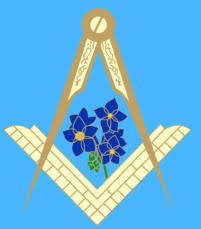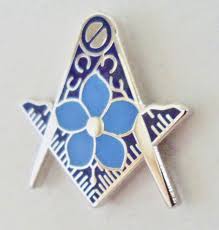The Forget-Me-Not
 Masonry has long used symbols to teach its valuable and important lessons. Every Mason is familiar with their usage. One of the most recent symbols that are associated with Masonry is the blue Forget-Me-Not flower. During the early 1930s, this delicate, little, five-petaled flower, which is similar to the common violet, became a symbol of Freemasonry in Nazi Germany and exemplified the spirit, dedication, and courage of men who held to their Masonic principles and beliefs in the face of gravest danger.
Masonry has long used symbols to teach its valuable and important lessons. Every Mason is familiar with their usage. One of the most recent symbols that are associated with Masonry is the blue Forget-Me-Not flower. During the early 1930s, this delicate, little, five-petaled flower, which is similar to the common violet, became a symbol of Freemasonry in Nazi Germany and exemplified the spirit, dedication, and courage of men who held to their Masonic principles and beliefs in the face of gravest danger.
Shortly after Adolph Hitler came to power in 1933, he issued two decrees. One provided for Nazi control over the educational process. The second made membership in a Masonic Fraternity a crime. Hitler viewed Freemasonry as part of “the Jewish conspiracy” and wanted it eradicated.
At that time there was 85,000 Masonry has long used symbols to teach its valuable and important lessons. Every Mason is familiar with their usage. One of the most recent symbols that are associated with Masonry is the blue Forget-Me-Not flower.
During the early 1930s, this delicate, little, five-petaled flower, which is similar to the common violet, became a symbol of Freemasonry in Nazi Germany and exemplified the spirit, dedication, and courage of men who held to their Masonic principles and beliefs in the face of gravest danger.
Shortly after Adolph Hitler came to power in 1933, he issued two decrees. One provided for Nazi control over the educational process. The second made membership in a Masonic Fraternity a crime. Hitler viewed Freemasonry as part of “the Jewish conspiracy” and wanted it eradicated. At that time there were 85,000 Masons in good standing in Germany.
Adolf Eichman, who would later play an important role in Hitler’s “final solution,” raided the Grand Lodge of Germany and confiscated all of their records including the names and addresses of 80,000 German Masons. Lodge property was confiscated and Eichman secretly issued orders that Masons should be put to death. His orders were followed.
The remaining 5,000 German Masons whose records were not found, immediately went underground hiding their records, lodge paraphernalia, and identifying jewelry. Active Freemasonry in Germany ceased to exist.
In 1934, members of the German Grand Lodge of the Sun (one of Germany’s pre-war Grand Lodges) began wearing the blue Forget-Me-Not  instead of the traditional square and compass on their lapels as a mark of identity for Masons. This was a Masonic secret that was never broken.
instead of the traditional square and compass on their lapels as a mark of identity for Masons. This was a Masonic secret that was never broken.
Throughout the whole era of Nazi domination, little blue Forget-Me-Nots appeared on lapels in cities and even in concentration camps, worn by brothers whose love of freedom, learning, and Freemasonry remained strong even under repressive Nazi rule.
In 1947, when the Grand Lodge of the Sun was reopened in Bayreuth by Past Grand Master Beyer, a pin in the shape of a Forget-Me-Not was adopted as an emblem of that first annual convention by those who had survived the bitter darkness of the Nazi era and were now able to openly rekindle the light of Freemasonry.
In 1948, the first Convent of the United Grand Lodges of Germany also adopted the pin as an official Masonic emblem honoring those brothers who had been forced to shelter the light of Freemasonry within but dared to wear the little flower openly. The tradition of using the blue Forget-Me-Not as a tribute to those whose fidelity to the Fraternity sets them apart was also used by the Masonic brotherhood of the blue Forget-Me-Not that recognizes the contributions of Masonic educators.
Although Adolph Hitler was able to destroy the outward vestiges of Freemasonry by desecrating temples and imprisoning or murdering Masons, he was never able to completely eradicate Freemasonry in Germany.
He was never able to understand that respect for individual rights and the love of liberty and learning will continue to burn in the hearts of some men, and that is the place where Masonry can endure even under the most repressive environment. Like the phoenix, Masonry rose out of the ashes of Nazi Germany (as it is also doing in several former communist block countries) as a tribute to the courage of
a man and the durability of those values and lessons that Masonry holds dear.
Roberts, Allen. Explanation of the Masonic Brotherhood of the Blue Forget-Me-Not.
Grand Lodge of Iowa, A.F. & A.M. Printing August 2002